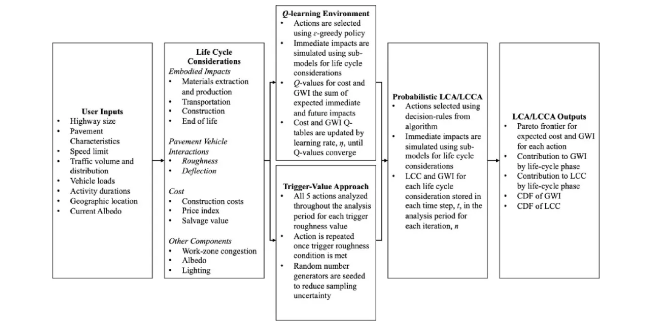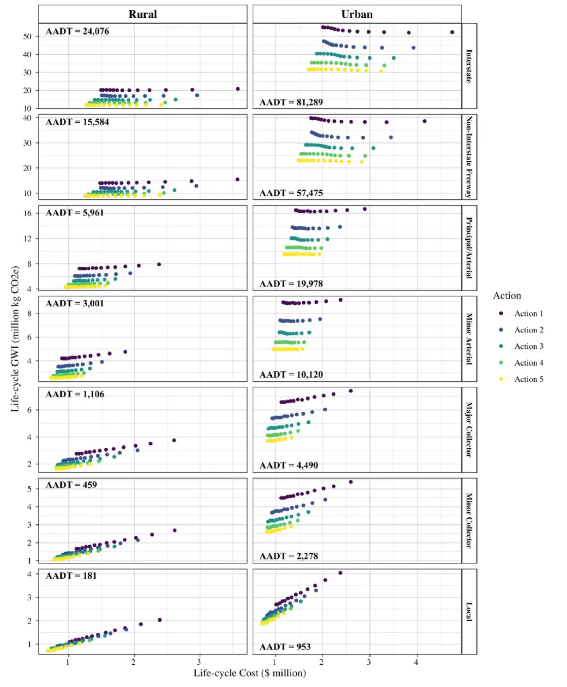 四川省绿色发展促进会
四川省绿色发展促进会

图片来源于网络(侵删)
文章导读
交通运输部门是全球变暖的最大贡献者之一,2018年占美国温室气体(GHG)排放的28%,占乘用车和卡车所有交通运输排放的82%。虽然减少交通运输温室气体排放的重点主要集中在提高车辆燃油效率和车队电气化上,但交通运输排放的很大一部分来自于我们广泛的铺设基础设施。路面基础设施的有效管理对于实现雄心勃勃的温室气体排放目标至关重要,特别是考虑到运输机构可获得的财政资源有限。在2017年,只有6%的州和地方政府开支是致力于高速公路和道路,导致积压8360亿美元的维修,系统扩展和系统改进,每五英里的公路路面是在一个贫穷的情况报告。路面基础设施的管理通过材料提取、施工、维护和报废活动直接导致全球变暖,并通过使用阶段和机制(如交通延迟、辐射强迫和滚动阻力)间接导致全球变暖。路面基础设施和环境之间复杂的相互作用,加上机构可用的资源有限,突出了决策支持工具的重要性,以确定成本效益高、环境可持续的管理策略。本研究详细介绍了一种新颖的、多目标的决策支持工具,旨在提高路面基础设施的可持续管理。该工具本身嵌入了两种算法,以帮助机构优化其初始设计以及维护和修复(M&R)的选择。这两种算法中的一种是新颖的q -学习算法,该算法尚未用于路面基础设施的多目标决策。
摘要
保护和更新运输系统使政府机构付出了巨大的代价,并对全球温室气体排放作出了重大贡献。在美国交通部分类的14个“平均”环境中,这项研究概率地评估了运输机构在管理其路面基础设施时可用的替代减少策略的生命周期成本和全球变暖影响。该研究依赖于两种算法方法来优化路面管理:触发值技术和强化学习算法。与交通量无关,我们的结果表明,通过简单地“预先”花费更多,运输机构不仅减少了其人行道对全球变暖的影响,而且在其生命周期内节省了资金。令人惊讶的是,这些节省对于通常由预算有限的地方市政当局管理的交通量较低的道路尤其显著。一个更高的“预先”投资可以降低全球变暖的影响和典型城市际公路的生命周期成本,分别降低19%和2%;当地城市道路的生命周期成本节省了近16%,同时其对全球变暖的影响也减少了16%。我们还表明,更频繁地修复低交通量的人行道不仅增加了机构支出,而且还增加了它们对全球变暖的影响。相反,通常由国家运输机构管理的交通量较大的公路,可以通过增加修复支出来减少其对全球变暖的影响。我们的发现为从业人员提供了有关可用路面管理策略的生命周期成本和节约的有价值的信息。

图1 集成LCA-LCCA工具的高级概述

图2 14个1英里路面案例研究的触发值预期GWI结果
原文信息
标题:
All roads lead to sustainability: Opportunities to reduce the life-cycle cost and global warming impact of U.S. roadways
作者:
Parsa Shani;Samson Chau;Omar Swei
单位:
a
Department of Civil Engineering, The University of British Columbia, CEME-2001, 6250 Applied Science Lane, Vancouver, British Columbia, Canada V6T 1Z4
英文摘要:
The preservation and renewal of our transport system come at a significant cost to governmental agencies and contribute significantly towards global greenhouse gas emissions. Across fourteen “average” contexts classified by the U.S. Department of Transportation, this study probabilistically evaluates the life-cycle cost and global warming impact of alternative abatement strategies available to transportation agencies in managing their pavement infrastructure. The research relies on two algorithmic approaches to optimize the management of pavements: a trigger-value technique and a reinforcement learning algorithm. Invariant to traffic volume, our results show that by simply spending more “up front”, transportation agencies not only reduce the global warming impact of their pavements but also save money over their life-cycle. Surprisingly, these savings are particularly noteworthy for lower traffic volume roads typically managed by local municipalities with limited budgets. A higher “up front” investment reduces the global warming impact and life-cycle cost for a typical urban interstate by 19% and 2%, respectively; those life-cycle cost savings grow to nearly 16% for a local urban road while its global warming impact is also mitigated by 16%. We also show that more frequent rehabilitation of lower traffic-volume pavements not only increases agency expenditures but also their global warming impact. Conversely, the global warming impact of larger traffic-volume roadways, which are typically managed by state transportation agencies, can be reduced through increased rehabilitation spending. Our findings provide practitioners with valuable information around the life-cycle cost and savings of available pavement management strategies.